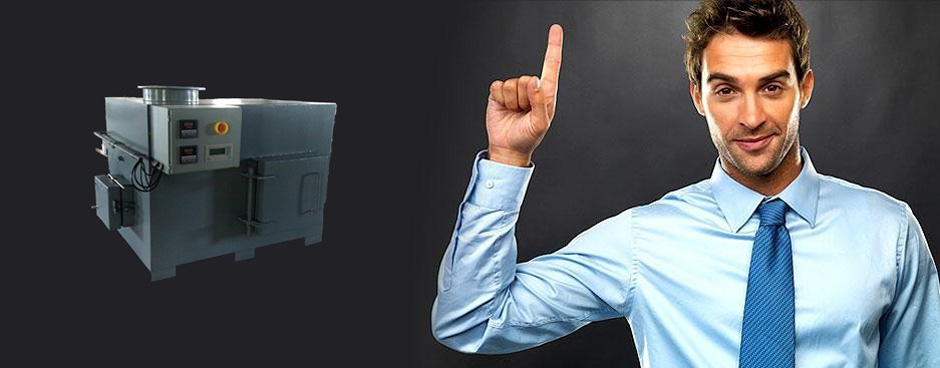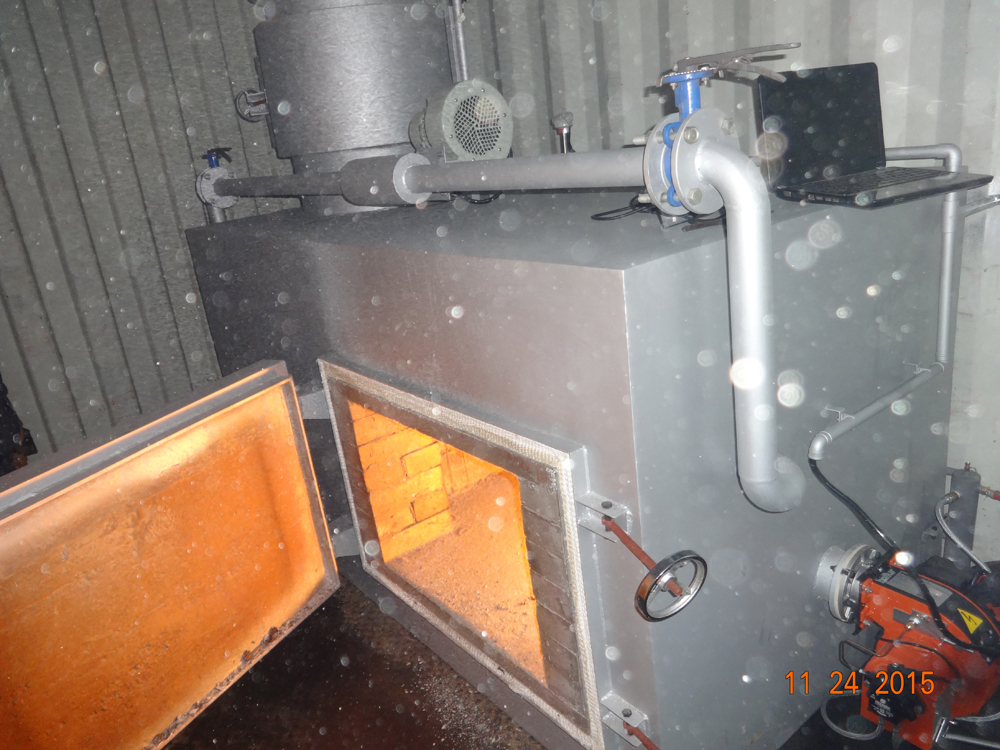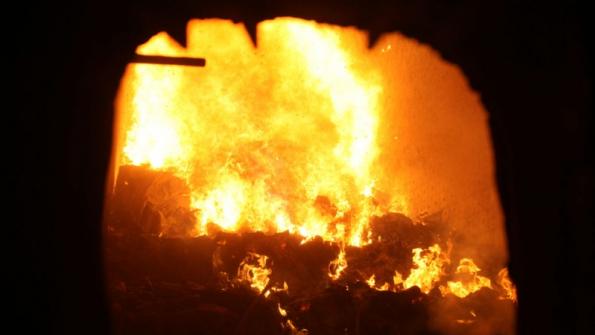1.CHARGEMENTSystème de chargement hydraulique afin de pouvoir charger le four en toute sécurité même durant son fonctionnement et aussi assurer la puissance destructive globale de 450 kg/j Le système comprend :1-1Trémie de chargement de forme parallélépipédique de 0,5 m3 de volume, réalisée en tôle d’acier, bridés sur la paroi frontale de la chambre de combustion et munie d’un couvercle à charnières actionné par vérin hydraulique .Dimensions :oLongueur 1200 mm oHauteur 700 mmoLargeur 600 1-2Un poussoir hydraulique assurera le chargement de la chambre de combustion1-3 Une porte de chargement de la chambre de combustion constituée d’une guillotine à vérin hydraulique revêtue de réfractaire 1-4Un central hydraulique pour piloter tous les vérins de commande, comprenant : réservoir, pompe, électrovannes et tuyauteries2.CHAMBRE DE COMBUSTION PRIMAIRE 2-1- Le bâti est une structure métallique cylindrique revêtue intérieurement d’une couche d’isolant et d’une couche de réfractaire.2-2-Volume intérieur : 1,65 m3 2-3-Aménagementportillon de décharge des cendres : frontal ; monté sur double charnière et revêtu de réfractaire avec hublot d’inspectionLa connexion à la chambre de chargement est revêtue de réfractaire La connexion de la chambre de combustion et de la chambre de post combustion est revêtue de réfractaireInstallation des bruleursInstallation du système de distribution de l’air comburant Installation des sondes de mesure de la températureLe bac de récolte des cendres est en acier au carbone sur roulettes, équipé de racloir métallique permettant l’évacuation manuelle des cendres 3. BRULEUR DE LA CHAMBRE DE COMBUSQTIONUn bruleur de type à une flamme à l’air soufflé, alimenté par gasoil, équipé des dispositifs de sécurité Puissance thermique installée 165 KW.4. AIR COMBURANTLe système de distribution et dosage de l’air primaire en chambre de combustion comprend :Ventilateur centrifugeCanalisations de distribution airSystéme de distribution d’air à 2 canauxSoupape de régulation de l’air motorisé selon les phases de cycle de fonctionnement et de la température 5. CHAMBRE DE POST COMBUSTION 5-1- Chambre de post combustion est installée au dessus du foyer de combustion , elle est constituée d’un cylindre métallique revêtu intérieurement d’une couche d’ isolant et d’une couche de matériaux réfractaires. 5-2- Volume intérieur : 2,1 m3Est dimensionnée pour pouvoir garantir un temps de fumée de 2 secondes à 1100°C avec un pourcentage d’oxygène libre d’au moins 6 %.5-3 -AccessoiresTrappe de visite boulonnée frontal pour permettre l’inspection périodiqueLa liaison à la chambre de combustion est tapissée de réfractaireInstallation les brûleursInstallation des sondes de mesure température6. PRODUCTION DE L’AIR COMBURANT DE LA CHAMBRE DE POST COMBUSTIONVentilateur centrifugeTuyauteries de distribution d’airSérie de vannes de distribution d’air Soupape de régulation de l’air soufflé asservi par la sonde du débit d’ oxygène
1.CHARGEMENTSystème de chargement hydraulique afin de pouvoir charger le four en toute sécurité même durant son fonctionnement et aussi assurer la puissance destructive globale de 450 kg/j Le système comprend :1-1Trémie de chargement de forme parallélépipédique de 0,5 m3 de volume, réalisée en tôle d’acier, bridés sur la paroi frontale de la chambre de combustion et munie d’un couvercle à charnières actionné par vérin hydraulique .Dimensions :oLongueur 1200 mm oHauteur 700 mmoLargeur 600 1-2Un poussoir hydraulique assurera le chargement de la chambre de combustion1-3 Une porte de chargement de la chambre de combustion constituée d’une guillotine à vérin hydraulique revêtue de réfractaire 1-4Un central hydraulique pour piloter tous les vérins de commande, comprenant : réservoir, pompe, électrovannes et tuyauteries2.CHAMBRE DE COMBUSTION PRIMAIRE 2-1- Le bâti est une structure métallique cylindrique revêtue intérieurement d’une couche d’isolant et d’une couche de réfractaire.2-2-Volume intérieur : 1,65 m3 2-3-Aménagementportillon de décharge des cendres : frontal ; monté sur double charnière et revêtu de réfractaire avec hublot d’inspectionLa connexion à la chambre de chargement est revêtue de réfractaire La connexion de la chambre de combustion et de la chambre de post combustion est revêtue de réfractaireInstallation des bruleursInstallation du système de distribution de l’air comburant Installation des sondes de mesure de la températureLe bac de récolte des cendres est en acier au carbone sur roulettes, équipé de racloir métallique permettant l’évacuation manuelle des cendres 3. BRULEUR DE LA CHAMBRE DE COMBUSQTIONUn bruleur de type à une flamme à l’air soufflé, alimenté par gasoil, équipé des dispositifs de sécurité Puissance thermique installée 165 KW.4. AIR COMBURANTLe système de distribution et dosage de l’air primaire en chambre de combustion comprend :Ventilateur centrifugeCanalisations de distribution airSystéme de distribution d’air à 2 canauxSoupape de régulation de l’air motorisé selon les phases de cycle de fonctionnement et de la température 5. CHAMBRE DE POST COMBUSTION 5-1- Chambre de post combustion est installée au dessus du foyer de combustion , elle est constituée d’un cylindre métallique revêtu intérieurement d’une couche d’ isolant et d’une couche de matériaux réfractaires. 5-2- Volume intérieur : 2,1 m3Est dimensionnée pour pouvoir garantir un temps de fumée de 2 secondes à 1100°C avec un pourcentage d’oxygène libre d’au moins 6 %.5-3 -AccessoiresTrappe de visite boulonnée frontal pour permettre l’inspection périodiqueLa liaison à la chambre de combustion est tapissée de réfractaireInstallation les brûleursInstallation des sondes de mesure température6. PRODUCTION DE L’AIR COMBURANT DE LA CHAMBRE DE POST COMBUSTIONVentilateur centrifugeTuyauteries de distribution d’airSérie de vannes de distribution d’air Soupape de régulation de l’air soufflé asservi par la sonde du débit d’ oxygène
Incinerator 20 Kg Incinerator electrically operated including: A cage for receipt of biomedical waste; A combustion chamber with fireplace with a filter to retain ashes; A cover; An air supply; A turbine allowing supply air. Combustion temperature: 1800 ° C. Comes with all accessories • Installing a readymade concrete base (Precast) with Height 30 cm above the ground and 20 cm below the surface of the earth. • The dimensions of the base are increased by (2 meters) from the edge of incinerators • The rest of the accessories in all the trends even allows the worker directly feeding and maintenance work, cleaning and move easily taking into account the tendencies of the base toward the door for drainage of water.• The floor coating must be high-quality epoxy paint.• Install anti-rust and heat Umbrella of brick and steel (pyramid shape) of (5) meters height above the ground which installed with the edge of the concrete base by thick galvanized columns • This umbrella Cover the site furnace and allow bringing the chimney• The site is surrounded by an iron fence (sheet metal) 3 meters height from the surface of the earth in order to protect the incinerators from dust storms • The iron fence must have a 5 meters Width gate • Automatic anti-rust and heat electrical circuit must be provided • The furnaces are highly efficient, emissions-free, safe, and environmentally friendly and have capacity of not less than 3,000 kg of materials and the rate of burning at least 400 kg / h• The method of feeding the furnace through a side slot or from the top and the emission of the smoke is completely prevented.• a furnace Must have two rooms, one of them is the main room of not less than the “5” stoves to the process of burning materials and other secondary room of not less “2” stoves to burn resulting gas from the first process as well as the chimney• The main component of the body of the furnace is stainless steel box, the thickness of not less than 7 mm with a layer of zinc phosphate plated with aluminium reflector to heat• the thickness of the door of 150 mm and a hardness of not less than 170 kg / m 3 to be burnt, automatic comprehensive remote system.• Furnaces must be destructive enough to burn and incinerate the material which mentioned previously • furnaces must have certificates are supported global enterprises and government competent for environmental protection In the country of origin or the General Presidency of Meteorology and Environment Protection in Saudi Arabia• The oven can work for 24 hours so as to allow for the burning of materials for a period of not less than 12 consecutive hours and the remainder for cooling and provides full fuel tank with a capacity of 1000 L to turn on the oven.• Must have an automatic ignition and diesel is used• a furnace has the ability to withstand extreme temperatures up to “130o c And also, it guarantees continuous operation of which can be utilized for 24 hours with the ability to remove residues during the work of the oven, Insulating layer of calcium must be present in the rooms with Thickness not less than 50 mm and a wall thickness of 100 mm • Isolation of burning room: the space between the walls must be of the “stainless steel”. In addition, burn room must fill with Thermal insulation material.• Ensure that the combustion of materials emitted in the secondary room should be at least two seconds period and the room is lined with high-density ceramic fibbers• Incinerators must contain a system for processing (purification) gasses before emission of the smoke.• Incinerators must have the capacity of self-cooling after the end of the daily operating period.• Incinerators must have chimney not less than “4 meters” height from the surface of the oven, also, it must be thermally insulated and non-rust able, and must also be removable, installation and tide default.• Electrical capacity required “220/ 380-volt “60 hertz• Incinerators must be fitted with a control panel of the electronic keys to monitor all the necessary indicators of activation keys, as well as start-up and switch off so as to be isolated inside a metal box with the presence of the following:Alarm Sensor in the event of (crashes “burner” or purification device or heat leakage or internal connections and wiring)Monitors for the temperature of the rooms Aerosols Filter indicators/ monitorsRoom temperature sensors Indicators for furnaces and index overloadTimer for Extinguish the oven automatically depending on the time required. • All equipment must be highly resistant to external conditions such as high temperature (50oc) • All doors must have special lock are not allowed non-persons appointed to work.• Providing fire extinguisher for each site with a capacity of 10 kg at least
Incinerator 20 Kg Incinerator electrically operated including: A cage for receipt of biomedical waste; A combustion chamber with fireplace with a filter to retain ashes; A cover; An air supply; A turbine allowing supply air. Combustion temperature: 1800 ° C. Comes with all accessories • Installing a readymade concrete base (Precast) with Height 30 cm above the ground and 20 cm below the surface of the earth. • The dimensions of the base are increased by (2 meters) from the edge of incinerators • The rest of the accessories in all the trends even allows the worker directly feeding and maintenance work, cleaning and move easily taking into account the tendencies of the base toward the door for drainage of water.• The floor coating must be high-quality epoxy paint.• Install anti-rust and heat Umbrella of brick and steel (pyramid shape) of (5) meters height above the ground which installed with the edge of the concrete base by thick galvanized columns • This umbrella Cover the site furnace and allow bringing the chimney• The site is surrounded by an iron fence (sheet metal) 3 meters height from the surface of the earth in order to protect the incinerators from dust storms • The iron fence must have a 5 meters Width gate • Automatic anti-rust and heat electrical circuit must be provided • The furnaces are highly efficient, emissions-free, safe, and environmentally friendly and have capacity of not less than 3,000 kg of materials and the rate of burning at least 400 kg / h• The method of feeding the furnace through a side slot or from the top and the emission of the smoke is completely prevented.• a furnace Must have two rooms, one of them is the main room of not less than the “5” stoves to the process of burning materials and other secondary room of not less “2” stoves to burn resulting gas from the first process as well as the chimney• The main component of the body of the furnace is stainless steel box, the thickness of not less than 7 mm with a layer of zinc phosphate plated with aluminium reflector to heat• the thickness of the door of 150 mm and a hardness of not less than 170 kg / m 3 to be burnt, automatic comprehensive remote system.• Furnaces must be destructive enough to burn and incinerate the material which mentioned previously • furnaces must have certificates are supported global enterprises and government competent for environmental protection In the country of origin or the General Presidency of Meteorology and Environment Protection in Saudi Arabia• The oven can work for 24 hours so as to allow for the burning of materials for a period of not less than 12 consecutive hours and the remainder for cooling and provides full fuel tank with a capacity of 1000 L to turn on the oven.• Must have an automatic ignition and diesel is used• a furnace has the ability to withstand extreme temperatures up to “130o c And also, it guarantees continuous operation of which can be utilized for 24 hours with the ability to remove residues during the work of the oven, Insulating layer of calcium must be present in the rooms with Thickness not less than 50 mm and a wall thickness of 100 mm • Isolation of burning room: the space between the walls must be of the “stainless steel”. In addition, burn room must fill with Thermal insulation material.• Ensure that the combustion of materials emitted in the secondary room should be at least two seconds period and the room is lined with high-density ceramic fibbers• Incinerators must contain a system for processing (purification) gasses before emission of the smoke.• Incinerators must have the capacity of self-cooling after the end of the daily operating period.• Incinerators must have chimney not less than “4 meters” height from the surface of the oven, also, it must be thermally insulated and non-rust able, and must also be removable, installation and tide default.• Electrical capacity required “220/ 380-volt “60 hertz• Incinerators must be fitted with a control panel of the electronic keys to monitor all the necessary indicators of activation keys, as well as start-up and switch off so as to be isolated inside a metal box with the presence of the following:Alarm Sensor in the event of (crashes “burner” or purification device or heat leakage or internal connections and wiring)Monitors for the temperature of the rooms Aerosols Filter indicators/ monitorsRoom temperature sensors Indicators for furnaces and index overloadTimer for Extinguish the oven automatically depending on the time required. • All equipment must be highly resistant to external conditions such as high temperature (50oc) • All doors must have special lock are not allowed non-persons appointed to work.• Providing fire extinguisher for each site with a capacity of 10 kg at least
i.Smoke and smell freeii.High Temperature , refractory lining with excellent heat retentioniii.Quick heat up timeiv.Must have a secondary chamberv.Constant run fanvi.Temperature monitoring vii.Thermostat Control Technical Specificationsi.Capacity : approx. 0.20 m3ii.Fuel consumption: 5 litres /hour Diesel Oiliii.Min Operating Temp: 900 oCiv.Max Operating Temp: 1350 oCv.Residence Time: 2 secvi.Burning rate: 35kg/hr minimum
i.Smoke and smell freeii.High Temperature , refractory lining with excellent heat retentioniii.Quick heat up timeiv.Must have a secondary chamberv.Constant run fanvi.Temperature monitoring vii.Thermostat Control Technical Specificationsi.Capacity : approx. 0.20 m3ii.Fuel consumption: 5 litres /hour Diesel Oiliii.Min Operating Temp: 900 oCiv.Max Operating Temp: 1350 oCv.Residence Time: 2 secvi.Burning rate: 35kg/hr minimum
The Biomedical Waste Incinerator is used for Incineration of each type of Biomedical Waste.The Disposal of such Biomedical waste is a very important as it is a dangerous wastes forhuman life, and It is only possible with a perfect incinerator.Operational RequirementsIt shall be operated by manual and automated mode.The combustion efficiency (CE) shall be at least 99.00%.The combustion efficiency is computed as follows:C.E.= __%CO2______ x 100%CO2 + %COEmission Standards: Lower emission rates are preferred.Parameters Concentration in mg/Nm3 (12% CO2 correctionMax total dust 30mg/m3Max Sulphur Dioxide 200mg/m3Max Nitrogen dioxide 400mg/m3Max Carbon 100mg/m3MonoxideMinimum stack height shall be 30 metres above ground.Volatile organic compounds in ash shall not be more than 0.01%.System ConfigurationBiomedical Waste Incinerator, complete unit.Technical SpecificationsIncinerator:It shall be Electrical or Diesel Fired Incinerator or Controlled Air & pyrolytic.Type of Waste: Biomedical WasteIt shall have burning capacity 10-15 kg/hr.Fuel: DieselBurner: Monoblock fully automatic burners.Temperature: Primary Chamber 800 ± 50 oC, Secondary Chamber 1050 ± 50 oC.Type of Waste: Biomedical waste with moisture content up to 85%.Destruction Efficiency: 99%.It shall have separate digital display of temperature for both chambers.It shall have provision for measuring primary & secondary chamber temperatures using externalthermo coupler.
The Biomedical Waste Incinerator is used for Incineration of each type of Biomedical Waste.The Disposal of such Biomedical waste is a very important as it is a dangerous wastes forhuman life, and It is only possible with a perfect incinerator.Operational RequirementsIt shall be operated by manual and automated mode.The combustion efficiency (CE) shall be at least 99.00%.The combustion efficiency is computed as follows:C.E.= __%CO2______ x 100%CO2 + %COEmission Standards: Lower emission rates are preferred.Parameters Concentration in mg/Nm3 (12% CO2 correctionMax total dust 30mg/m3Max Sulphur Dioxide 200mg/m3Max Nitrogen dioxide 400mg/m3Max Carbon 100mg/m3MonoxideMinimum stack height shall be 30 metres above ground.Volatile organic compounds in ash shall not be more than 0.01%.System ConfigurationBiomedical Waste Incinerator, complete unit.Technical SpecificationsIncinerator:It shall be Electrical or Diesel Fired Incinerator or Controlled Air & pyrolytic.Type of Waste: Biomedical WasteIt shall have burning capacity 10-15 kg/hr.Fuel: DieselBurner: Monoblock fully automatic burners.Temperature: Primary Chamber 800 ± 50 oC, Secondary Chamber 1050 ± 50 oC.Type of Waste: Biomedical waste with moisture content up to 85%.Destruction Efficiency: 99%.It shall have separate digital display of temperature for both chambers.It shall have provision for measuring primary & secondary chamber temperatures using externalthermo coupler.
Smaller cremators that will run diesel and will be capable of doing all the other dogs/cats/pets that we have. We only cremate pets individually so this is what we require. Have your company as member of Markis Hospital waste management group as planer or supplier, contractor of solutions or operating partners of the solution of hospital waste management in the projects we are developing, starting with Larissa and Volos. Members of Markis waste management group will also have the possibility to provide training and technical services to the health sector of Greece and other countries via the TSC which we plan to make the same time in Larissa (enclosed diagram indicates the role of each party joining Markis waste management group). ● Able to burn 25-30kg per hour ● Consist of two chambers to ensure significant reduction in emission ● Be capable of temperature in range of 800c to 1000c ● Low maintenance design ● Must be Diesel fuelled ● Need more than 15amp 220- 250V power ● kW Consumption power consumption to be stated ● Onboard or in-built fuel storage storage tank & should use no more than 12L of dies el per hour to burn 25-30kg of waste ● Solid waste reduction in range of 90-97% ( should be routinely achieved) 1. – 2 medical waste autoclaves 350ltr and 100ltr 2. – 1 medical waste shredder 3. – 3 medical macerators 4. – 27 Waste transfer trolleys.
Smaller cremators that will run diesel and will be capable of doing all the other dogs/cats/pets that we have. We only cremate pets individually so this is what we require. Have your company as member of Markis Hospital waste management group as planer or supplier, contractor of solutions or operating partners of the solution of hospital waste management in the projects we are developing, starting with Larissa and Volos. Members of Markis waste management group will also have the possibility to provide training and technical services to the health sector of Greece and other countries via the TSC which we plan to make the same time in Larissa (enclosed diagram indicates the role of each party joining Markis waste management group). ● Able to burn 25-30kg per hour ● Consist of two chambers to ensure significant reduction in emission ● Be capable of temperature in range of 800c to 1000c ● Low maintenance design ● Must be Diesel fuelled ● Need more than 15amp 220- 250V power ● kW Consumption power consumption to be stated ● Onboard or in-built fuel storage storage tank & should use no more than 12L of dies el per hour to burn 25-30kg of waste ● Solid waste reduction in range of 90-97% ( should be routinely achieved) 1. – 2 medical waste autoclaves 350ltr and 100ltr 2. – 1 medical waste shredder 3. – 3 medical macerators 4. – 27 Waste transfer trolleys.









